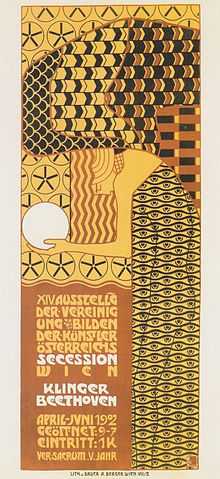Alfred Roller

Alfred Roller (2 October 1864 — 21 June 1935) was an Austrian painter, graphic designer, and set designer.
Life and work
Roller was born in Brünn, Mähren. He at first studied painting at the Academy of Fine Arts in Vienna under Christian Griepenkerl and Eduard Peithner von Lichtenfels, but eventually became disenchanted with the Academy's traditionalism. In 1897 he co-founded the Viennese Secession with Koloman Moser, Joseph Maria Olbrich, Josef Hoffmann, Gustav Klimt, and other artists who rejected the prevalent academic style of art.[1] He became a professor of drawing at the University of Applied Arts Vienna (Kunstgewerbeschule) in 1899, and president of the Secession in 1902.
In his early career Roller was very active as a graphic designer and draughtsman. He designed numerous covers and vignettes for the pages the Secessionist periodical Ver Sacrum, as well as the posters for the fourth, fourteenth, and sixteenth Secession exhibitions. He also designed the layout of the exhibitions themselves.
In 1902 Roller was introduced to the composer Gustav Mahler by Carl Moll. Roller expressed an interest in stage design and showed Mahler several sketches he had made for Wagner's Tristan und Isolde. Mahler was impressed and decided to employ Roller to design the sets for a new production of the piece. The production, which premiered in February 1903, was a great critical success. Roller continued to design sets for Mahler's productions. Eventually Roller left the Secession and his teaching post at the Kunstgewerbeschule to be appointed chief stage designer to the Vienna State Opera, a position he held until 1909. He died in Vienna in 1935.
Further reading
- W. Greisenegger - E. Lebensaft: "Roller Alfred". In: Österreichisches Biographisches Lexikon 1815–1950 (ÖBL). Vol. 9, Austrian Academy of Sciences, Vienna 1988, ISBN 3-7001-1483-4, p. 224–226. (Direct links to "p. 224", "p. 225", "p. 226")
- Greisenegger, Wolfgang (1989). "Alfred Roller: Neubedeutung des szenischen Raumes". Studia Musicologica Scientiarum Hungaricae (in German) (Budapest: Akadémiai Kiadó) 31 (1): 271–281. ISSN 1588-2888. JSTOR 902336.
- Ulrike Krone-Balcke (2005), "Roller, Alfred", Neue Deutsche Biographie (NDB) (in German) 22, Berlin: Duncker & Humblot, pp. 13–15, (full text online)
- Thursby, Stephen Carlton. “Gustav Mahler, Alfred Roller, and the Wagnerian Gesamtkunstwerk: Tristan and Affinities between the Arts at the Vienna Court Opera.” PhD diss., Florida State University, 2009.
- Vergo, Peter (1975). Art in Vienna 1898-1918: Klimt, Kokoschka, Schiele, and their Contemporaries. London: Phaidon. ISBN 0-7148-1600-0.
- Wagner, Manfred (1996). Alfred Roller in seiner Zeit (in German). Salzburg and Vienna: Residenz. ISBN 3-7017-0960-2.
References
- ↑ "Ordentliche Mitglieder" [Ordinary Members]. Ver Sacrum 1: 28. 1898.
External links
-
 Media related to Alfred Roller at Wikimedia Commons
Media related to Alfred Roller at Wikimedia Commons - Entry for Alfred Roller on the Union List of Artist Names
- Literature by and about Alfred Roller in the German National Library catalogue
|